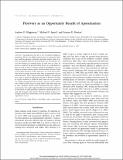Files in this item
Florivory as an opportunity benefit of aposematism
Item metadata
| dc.contributor.author | Higginson, Andrew D. | |
| dc.contributor.author | Speed, Michael P. | |
| dc.contributor.author | Ruxton, Graeme D. | |
| dc.date.accessioned | 2017-02-22T12:30:10Z | |
| dc.date.available | 2017-02-22T12:30:10Z | |
| dc.date.issued | 2015-12 | |
| dc.identifier | 244287845 | |
| dc.identifier | c531185f-4be2-4873-98ca-ab044cfc9a86 | |
| dc.identifier | 000365307700007 | |
| dc.identifier | 84947609304 | |
| dc.identifier | 26655980 | |
| dc.identifier | 000365307700007 | |
| dc.identifier.citation | Higginson , A D , Speed , M P & Ruxton , G D 2015 , ' Florivory as an opportunity benefit of aposematism ' , American Naturalist , vol. 186 , no. 6 , pp. 728-741 . https://doi.org/10.1086/683463 | en |
| dc.identifier.issn | 0003-0147 | |
| dc.identifier.other | ORCID: /0000-0001-8943-6609/work/60427515 | |
| dc.identifier.uri | https://hdl.handle.net/10023/10333 | |
| dc.description | A.D.H. was supported by the European Research Council (Advanced Grant 250209 to A. Houston) and fellowships from the Wissenschaftskolleg zu Berlin and the Natural Environment Research Council (NE/L011921/1). | en |
| dc.description.abstract | Inconspicuous prey pay a cost of reduced feeding opportunities. Flowers are highly nutritious but are positioned where prey would be apparent to predators and often contain toxins to reduce consumption. However, many herbivores are specialized to subvert these defenses by retaining toxins for their own use. Here, we present a model of the growth and life history of a small herbivore that can feed on leaves or flowers during its development and can change its primary defense against visual predators between crypsis and warning coloration. When herbivores can retain plant toxins, their fitness is greatly increased when they are aposematic and can consume flowers. Thus, toxin sequestration leading to aposematism may enable a significant opportunity benefit for florivory. Florivory by cryptic herbivores is predicted when toxins are very potent but are at high concentration only in flowers and not in leaves. Herbivores should usually switch to eating flowers only when large and in most conditions should switch simultaneously from crypsis to aposematism. Our results suggest that florivory should be widespread in later instars of small aposematic herbivores and should be associated with ontogenic color change. Florivory is likely to play an underappreciated role in herbivorous insect life histories and host plant reproductive success. | |
| dc.format.extent | 14 | |
| dc.format.extent | 1742715 | |
| dc.language.iso | eng | |
| dc.relation.ispartof | American Naturalist | en |
| dc.subject | Flower-eating | en |
| dc.subject | Folivory | en |
| dc.subject | Camouflage | en |
| dc.subject | Crypsis | en |
| dc.subject | Sequestration | en |
| dc.subject | Toxins | en |
| dc.subject | QH301 Biology | en |
| dc.subject.lcc | QH301 | en |
| dc.title | Florivory as an opportunity benefit of aposematism | en |
| dc.type | Journal article | en |
| dc.contributor.institution | University of St Andrews. School of Biology | en |
| dc.contributor.institution | University of St Andrews. Centre for Biological Diversity | en |
| dc.identifier.doi | https://doi.org/10.1086/683463 | |
| dc.description.status | Peer reviewed | en |
This item appears in the following Collection(s)
Items in the St Andrews Research Repository are protected by copyright, with all rights reserved, unless otherwise indicated.

